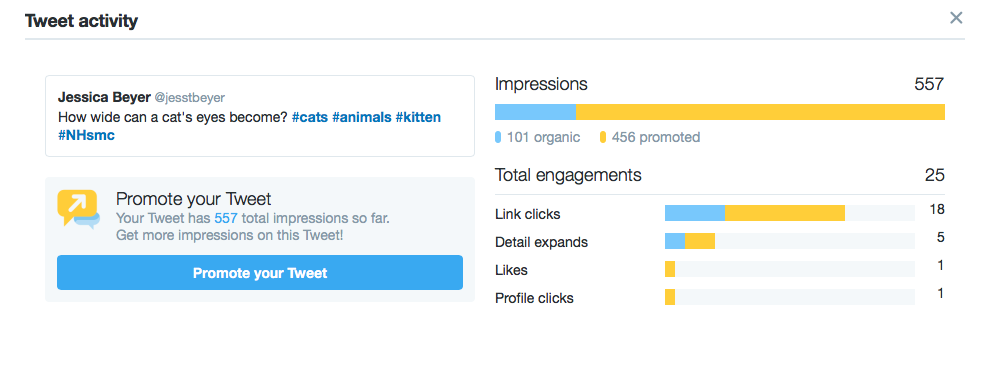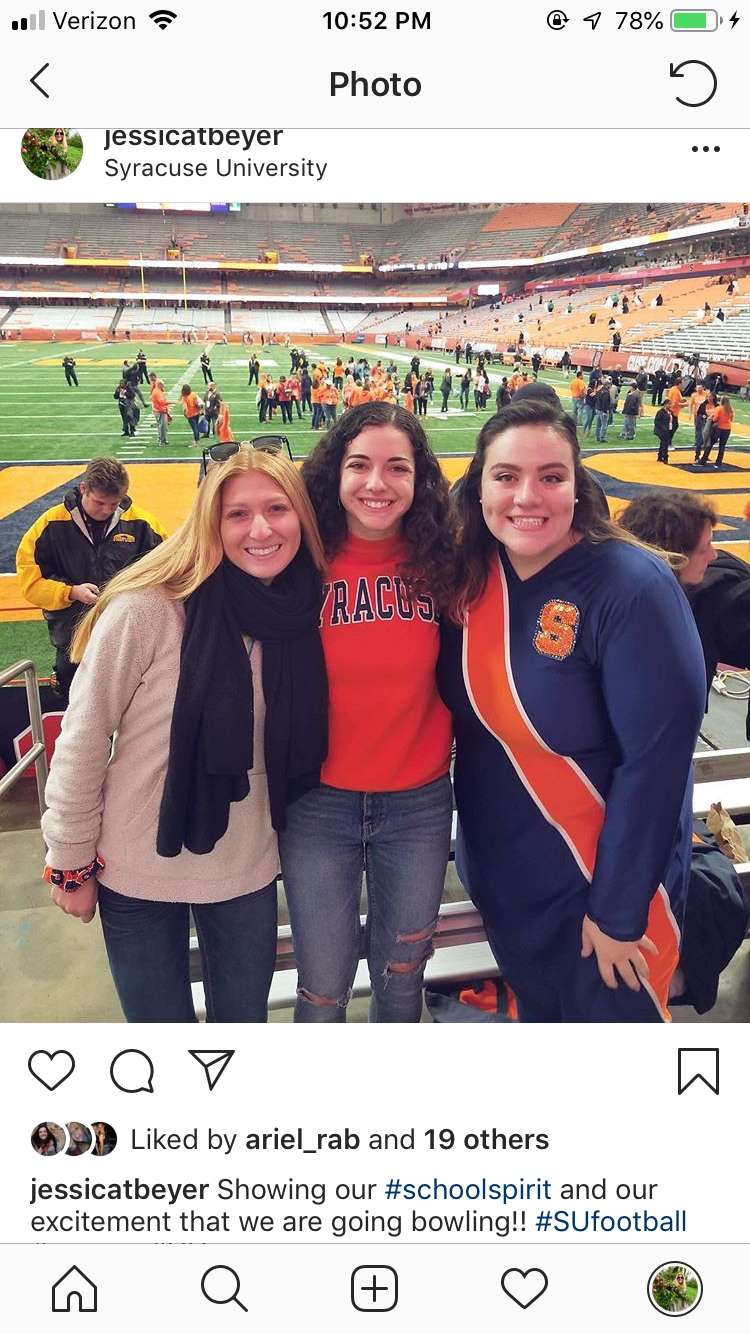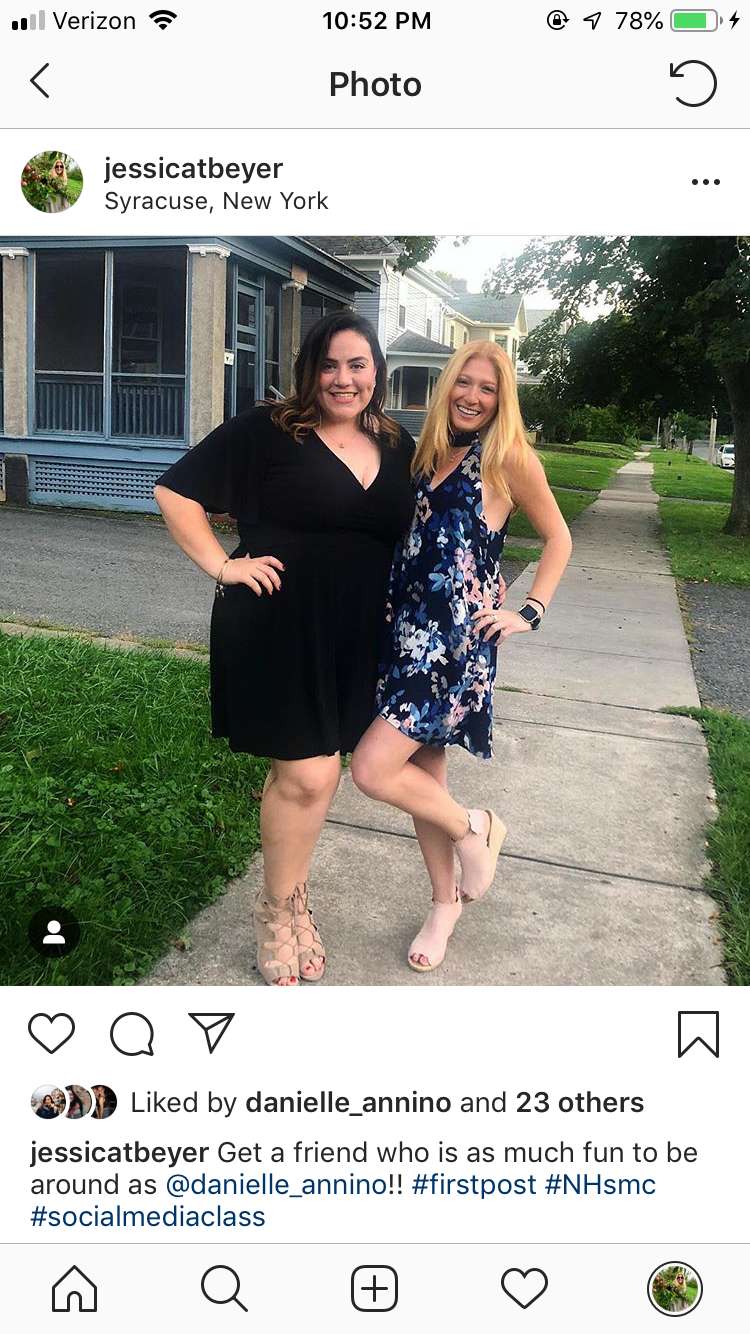Part 1:
As someone who hasn’t used Twitter in five years, I had some learning and catching up to do. From what I remembered, the platform pretty much looked the same as it did five years ago, but my network had drastically changed; this is why I decided to create a new Twitter account to serve as a business account and a fresh start for this social media class. Starting a new account means starting with a total of 0 followers. Because it has been so long since I built my following network from high school, I had to work hard to create a new following. By 11/28/18, I have gained 38 followers, starting from my original 0. Because I started with 0, I cannot calculate a percentage of growth (because one cannot divide a number by 0), but hypothetically, if I started with 1 follower, and then gained 38 new followers, there would be a percentage increase or percentage of growth of 3700%. This is a rather large number, so this metric may be deceiving to someone trying to analyze how may followers I have gained over the course of the time period between 8/29-11/28. For Instagram, I started with 0 and now have 51 followers.
Professor Grygiel’s tips were extremely helpful when it came to producing content and gaining a follower base. My tweets garnered the most attention when there was rich media involved and hashtags. Professor Grygiel gave the noteworthy advice that using hashtags will attract people to one’s account because people follow hashtags. I tried to use general hashtags as I was instructed to use because this would bring in a larger audience than using specific hashtags that have a more narrow following. According to Twitter Analytics, I can see that my first tweet received a high number of impressions. As Professor Grygiel referred to in the viral content challenge, it is often when you first launch something that people pay the most attention to your content. My first tweet received over 1,000 impressions (which is high for me), while my tweets thereafter only were receiving a couple hundred impressions. There were a few exceptions to this, one of which was my #followfriday tweet, which included images, making it more interactive. I also tagged three popular companies, which could have potentially accounted for the higher number of impressions than normal. My engagement rate, which on average was roughly 5% over the allotted time frame, spiked on a few of my tweets. Two tweets where engagement was notable was on my tweet about my trip to Oswegatchie (13.7%), which included an image, and my tweet tagging my popular Twitter friend, Josh (12.8%).
As referenced earlier, I found using more general hashtags as opposed to more specific ones generated a higher engagement rate. I was using such specific hashtags such as #runforacause instead of just #running and #uhoh #expression (4.6% engagement rate) for my meme instead of just #animals (7.9%), which I later used and garnered more impressions and a higher engagement rate than the tweet with the specific hashtags. Going forward, I know to use images, rich media, and general hashtags, as well as look at what time my audience is most active and schedule tweets in Tweetdeck at these times. I found that tagging people and including links for people to click on gave my content more attention than those without anything to click on or further investigate. I also should have tried to engage with more micro influencers to try to gain more followers. Through class assignments and testing of my own, I was able to deduce the best practices to run a successful Twitter account. What I also plan to do going forward, is search my followers’ interests and see which accounts they are following, and try to replicate the content of those accounts or introduce more content relating to the interests of my followers. Maybe this would even result in a follow from the original account. Professor Grygiel also taught me the importance of answering people you reach out to in a timely manner. I reached out to a woman from NASA who was previewing the First Man movie, and she responded very quickly by replying to my original tweet. It was not until the next afternoon did I see her response. My goal is to keep people engaged and wanting more from my account, so this will involve tending to my account more. I will try to emulate those who garner much engagement in order to find a tone and voice that represents me, but that also resonates with my followers.
Part 2:
On Twitter and Instagram, I deployed the tactics spoken about in class in order to raise my engagement. Some of these tactics (for Instagram) included keeping with a consistent color scheme, using appropriate filters for content matter, staying on public, and using hashtags. For Twitter, some of the tactics I used was sometimes scheduling my tweets in Tweetdeck when I saw my audience was most active, using rich media, including links for people to click on, utilizing the features such as moments, engaging with micro and macro influencers, participating in trends such as #followfriday, and promoting a tweet to receive more impressions and clicks. What I lacked in, was making sure my natural voice came through in my tweets. My tweets and posts were more serious on Twitter than they were on Instagram, making it so my tweets were relatively dry and not fun. This could potentially be a reason why I did not gain as many followers from start to end as I would have liked; my content potentially didn’t connect on a human level or on a deep enough level for people to stay interested.
Here are my top 10 posts I pulled from Twitter Analytics and Instagram based on impressions and engagement:
This tweet is my #followfriday tweet where I tagged three popular companies and included pictures of the three CEOs respectively. This was part of the hashtag that goes out every Friday as a trend on Twitter. This tweet garnered the highest number of impressions of all my tweets over the time frame 8/29-11/28. However, the engagement was relatively low. This could possibly be because the pictures are low quality and it is not engaging. What I could have done better is provided links to each of the websites of the companies I tagged. When people see links, they are likely to engage and click on them. The hashtag #followfriday is probably what made me receive such a high number of impressions in comparison to my other tweets. I also could have included more hashtags like the names of the companies or the names of the CEOs. I did not receive any likes, comments, or retweets, but I did take a step to try to include images as suggested in class.
This tweet received a relatively high number of impressions in comparison to my other tweets, in addition to receiving an incredibly high number of engagements. This tweet received one retweet. I used Google Trends to compare Kate Middleton and Meghan Markle to uncover an insight. I tried to used more general hashtags like #BritishRoyalty. It was probably unnecessary to hashtag “google trends” looking back, but in any case, if someone likes looking at google trend charts, they might follow the hashtag, thus leading them to my tweet. I think the fact that I had an image and something for people to study helped to garner the amount of engagement I did. I would be curious to know if I used less popular names and did a comparison if I would receive more, less, or the same amount of engagement on this tweet. I was hoping to get some commentary on this tweet as British Royalty is a hot topic. This lack of commentary could be from my followers mostly being from the USA. Next time I should research the interests of my followers and do a Google Trends analysis on that to potentially receive more engagement.
In this tweet I tagged my friend, Josh, who tweets quite frequently and has received up to almost 200 likes on one tweet. This screenshot is one of three linked tweets that I did for the “Twitter rant” assignment. This tweet alone received a high number of engagements. Josh also responded to these tweets, which sparked a rise in engagement. I believe this tweet was able to uncover my personality a little bit more than some of my other tweets. I used an exclamation point and showed a connection to another person. In the second half of this reply tweet, I received another 3 likes on the images of Josh’s tweets I used for examples of his content. This taught me that when I say something, it is best to have examples as to why I thought and said what I did. If I just said Josh’s tweets are very funny without providing some of my favorites, I do not think this tweet would have done as well as it did.
This tweet received a whopping 5 favorites. I used images from my abroad experience in London, and also tagged a friend of mine in the class who also studied abroad in London. Annaya also replied to me, increasing my engagement percentage. The pictures were of iconic sites in London- very opulent landmarks. This tweet allowed me to share a personal experience and share it with someone else. I provided details in this tweet instead of general statements, which I believe is what attracted people to the tweet. I have undoubtedly noticed that using images in a tweet calls for more engagement than a tweet with no media at all. I could have used this opportunity to use more hashtags as I only used the class hashtag. In addition, I could have kept the conversation going with Annaya instead of letting it dissolve after one exchange. Next time, I will try to continue to engage someone in the hopes of another person jumping in to share his or her experience. Lastly, posing a question in a tweet prompts people to respond more often than not. I wonder if “opening the door” for people to answer and engage will boost my engagement numbers in the future.
In this tweet, I was trying to target a niche audience as we learned in class can sometimes help with interaction levels. I should have used a hashtag pertaining to my tweet’s content to attract the audience interested in eating healthy. I could have used #healthy #vegan. As seen here, I tried posing a question again (this time more rhetorical) to see if it resulted in any engagement. I received one favorite and it was from an account that was encouraging people to ditch their old diets and to live healthier. I also tried to offer a purpose to my tweet and add a benefit to what I was promoting. I want people to know that eating healthy can help them feel more energized, so this should be an incentive to do so. In the future, I want to try to continue to tweet about a vegan lifestyle to see if those who follow these healthy accounts religiously would follow me.
In the above tweet, I was showing my experience at a place in upstate NY called Oswegatchie. I wanted people’s interests to spike and then check back for more information on my trip at a later time that night, hence “more to come.” I should have used a more general hashtag than #staytuned, because that is not something people would naturally search for. I included three images, which went over well, because I received 5 likes this tweet. I found that the tweets that include me in them garner the most attention. I believe this is because people like to see other people’s experiences and their reactions. Seeing a person’s face is more telling than snapping a picture of one’s surroundings sometimes. I could have tagged the girls in the photo with me as well. I chose to include photos at different parts of my day to give my viewers a well-rounded picture of my trip. To get more impressions, next time maybe I would choose to promote this tweet if I wanted to do a campaign on excursions or nature.
The above tweet shows a moment I made about Nike and their Colin Kaepernick campaign. At the time of me making this moment collection, this was an incredibly debated topic, because people saw Nike’s campaign in two completely different lights. I decided to capture these two opposing sides in a moment, using tweets to capture the essence of each side’s arguments. This tweet received two likes. I should have included a tag for Nike and a few hashtags that complemented my tweet’s content, such as #debate #Nike. I believe that this tweet received the engagement it did because of the timeliness of my releasing of this moment. Many topics on Twitter are time sensitive, making engagement more likely. In retrospect, I could have also posed the question, to spark commentary, “which side are you on?” I could also have created a poll, received the results, and then tweeted at Nike. I would like to try this process for one of my future moments.

This tweet is the tweet I promoted for the viral content challenge. This tweet included my webcard which when clicked linked to my Imgur site where my meme was housed. My meme received just short of 2,300 views. Because I chose this tweet to promote, I was able to see that I received 456 promoted impressions while 101 of these were organic. This promotion resulted in 18 link clicks, which added to the number of views I received on Imgur, and additionally it received one like. The idea of using a webcard is brilliant because as we learned in class, it is a way to advertise content without giving too much away, thus prompting the user to click on the card to see what the rest of the image is. I enjoyed monitoring my campaign and creating a webcard to track the engagement level, so I will be conducting one of these again in the future. Next time, I will try to target an audience better (set it in Twitter ads) to receive more engagement and link clicks. Maybe I could try to target a specific account that is directly related to my content.

For this Instagram post, I received 20 likes, with only 48 followers at the time. I chose to take what I learned from Twitter, which is uploading photos with me in them, and apply it to Instagram. I used general hashtags that could be used at any middle school, high school, or college, like #schoolspirit, and I used a popular hashtag among the SU community, #SUfootball. I used “football vernacular” by saying “we are going bowling” to express my own excitement about SyracuseU making a bowl game. I tagged my two friends in the photo, so their followers would be able to see the photo and like it. This picture received the second highest number of likes of all my pictures. I added a blue hue over the photo to make it blend with my other blue photos on my profile. I also chose to tag the location so the picture would come up when searching for Syracuse University.

Similarly to Twitter and Imgur, this was my first Instagram post, and I received the highest number of likes that I have on any of my other photos. When I was promoting my Imgur meme, and when I first uploaded it to Imgur, it was clear that if the meme did not do well and gain a lot of views when I first posted it, the prospects looked bleak going forward. I know this because I posted once where I didn’t receive more than 150 views within the first 10 minutes, and then tried again at a different time and day and received over 500 views within the first 10 minutes. I chose to emphasize that this was my first post with the hashtag “first post,” and I chose to let my followers know the purpose of my account through a hashtag. I probably could have done a better job using hashtags to promote the content in the post though to attract more attention. I both included Danielle’s tag in the photo and in the caption to make sure her followers were able to find the photo. I used my knowledge of me being in the photo to logically choose what my first post should be. As it turns out, the two pictures that include a friend (or multiple friends) and me garnered the most likes. This shows that the strategies that work on Twitter are sometimes transferrable to Instagram. The bluish background and vibrancy of my blue dress is what decided the overall blue hue trend throughout my future posts.
Overall, this class helped me expand my knowledge on best practices to use on Twitter and Instagram through hands-on experience, which proved extremely helpful to better my understanding of how to post my own content to maximize engagement.